1. Introduction
A breakthrough in astronomy was the development of the theory of stellar evolution throughout the 20th century. It was Ejnar Hertzsprung and Henry Norris Russell who first plotted the stars’ temperatures against their brightness [1]. This method stimulated the investigation of stellar evolution theories. The discovery that stars evolve over time became the primary impetus for future interstellar travel projects. As a main sequence star ages, it uses up all its hydrogen in the core and starts fusing helium. During this process, the star will go through a bunch of changes in its internal structure. As a result, the star becomes hotter, larger, and brighter as it leaves its main sequence phase [2]. The sun is currently in its middle age of main sequence life, so it will become hotter and much larger as a red giant. Unfortunately, earth's orbit will be swallowed by that future red giant, and thus human beings need to find a new home before it happens. This implies that human must address the question of how to travel between planets in different solar systems.
In this paper, I will introduce several important questions to consider when designing spacecrafts capable of intergalactic travel, as well as methods to address them. How will the spacecraft hold enough power for long term travel? How will the spacecraft control its orientation? How will the spacecraft determine its position and velocity relative to celestial objects? How can the spacecraft identify solar systems to refuel at during the trip, and find habitable planets to immigrate to? Possible Answers to all the above questions will be discussed in this paper. Most the spacecraft’s energy supply will come from photoelectric panels. Photoelectric panels can convert solar radiation to usable electric energy. The attitude control system is based on the solution to cat falling problem where the spacecraft can turn without an external force exerting on it. The navigation system relies on telescopes that can observe radiations from other star systems to determine the identity and position of the star relative to the spacecraft.
2. Design Overview
The objectives of the design of energy, attitude control and navigation systems on the spacecraft are to be sustainable for long distance interstellar travel. This assumes of taking the solar system as an example of any generic star-planetary system that the ship will encounter during the journey. On another hand, as star-planetary systems are extremely sparsely scattered in the universe, compared to their sizes. Thus, when the spacecraft is travelling through interstellar space, it can glide through with very little energy consumption without the need to accelerate, decelerate or steer.
3. Power Source
3.1. Introduction of Power Source
The power system is inevitably one of the most important parts of the spacecraft. To be sustainable for long distance journeys, the power system of the spacecraft must be renewable and durable for long travel distance. Although sending human astronauts far away require great amount of energy, the universe itself can surely shoulder the energy supply as it is where all types of high energy objects exist and output power flux into the surrounding space. The only real problem about power supply is the way to make use of the nearly unlimited energy from the universe. The total energy is conserved in the space, but scattered in various forms. The challenge of a long-term travel spacecraft is to gather enough energy when approaching a nearby power source and to be able to consume less when drifting through the vast space between two sources. This idea is the core to the design of power system. The main strategy for lengthening the life span of power usage is to gather more energy from the starting point and consume less until other energy source is reached, so that energy provide is enough for another long-term travel. Figure 1 shows a circular relationship between “energy gathering” and “energy consuming”. The spacecraft is going to work in a combination of the two statuses.
3.2. Energy Gathering

Figure 1. The visual circulation between energy gathering and energy consuming.
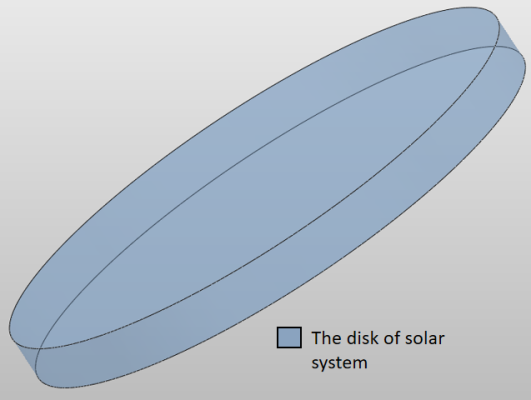
Figure 2. Schematic diagram of the solar system where the astronomical objects are presented to scale.
The vital problem for energy gathering is fuels. Though the universe serves as the most abundant energy reservoir, it is also vast and vacant in most space which raises the difficulty of finding available energy source. Large amount of non-renewable energy exists as patches of liquid or solid. They attracted each other and formed planets that occupied a very tiny space. In fact, the percentage is so small that it is even hard to put the planets into a graph by scale. Figure 2 is a schematic diagram of the solar system where the astronomical objects are presented to scale. The radius of the cylinder is thirty arbitrary units which represents the distance between the outermost planet of the solar system, Neptune, and the sun. However, it is even hard to see the biggest object in solar system, the sun, in this cylindrical space. All that can be seen is vacancy. However, by magnifying the radius of the planets and contracting the actual lengths between them, a presumable image of the solar system which is not to scale can be drawn, in Figure 3 for instance.
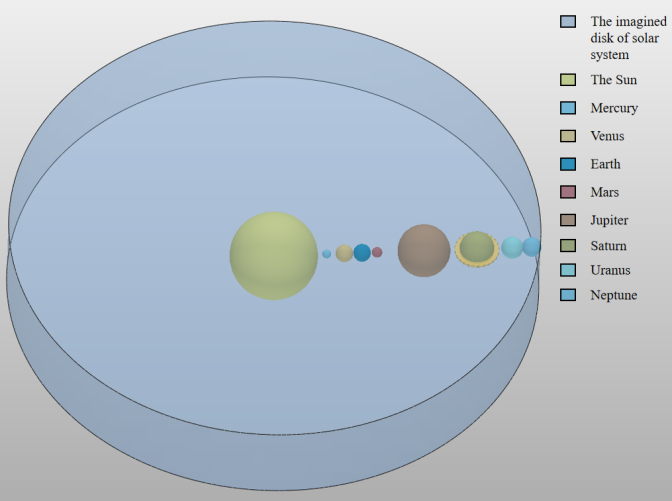
Figure 3. Schematic diagram of the solar system where the astronomical objects are not to scale.
Table 1. Sizes and distances of the solar system [3].
Astronomical Object | Distance to the sun (AU) | Distance to the sun (km) | Diameter (km) |
Sun | - | - | 1,391,400 |
Mercury | 0.39 | 57,900,000 | 4,879 |
Venus | 0.72 | 108,200,000 | 12,104 |
Earth | 1 | 149,600,000 | 12,756 |
Mars | 1.52 | 227,900,000 | 6,792 |
Jupiter | 5.2 | 778,600,000 | 142,984 |
Saturn | 9.54 | 1,433,500,000 | 120,536 |
Uranus | 19.2 | 2,872,500,000 | 51,118 |
Neptune | 30.06 | 4,495,100,000 | 49,528 |
The measured sizes of stellar objects and distances between them are listed in table 1. Using Table 1, it is simple to estimate the ratio between the volume of the astronomical objects and the volume of vacancy in the solar system, represented by R. The asteroids and other astronomical units are relatively little and hard to add together, so they are neglected in the calculation.
\( R=\frac{\sum {V_{the sun and planets}}}{{V_{the imagined cylinder of solar system}}} \) (1)
\( R=\frac{\frac{4}{3}×π×[{(1391400km)^{3}}+{(4879km)^{3}}+...+{(49528km)^{3}}]}{{(30.06AU)^{2}}×π×1391400km} \) (2)
\( R≈1.28×{10^{-7}} \) (3)
The number implies that there is approximately one cubic kilometer of real substance in a million cubic kilometers of vacant space on average in solar system. In the vast universe this represents the difficulty of finding non-renewable energy like coal and natural gas. Comparing to other types of energy, solar energy is the easiest to find under such conditions. This implies that travel is going to rely mostly on collected solar energy.
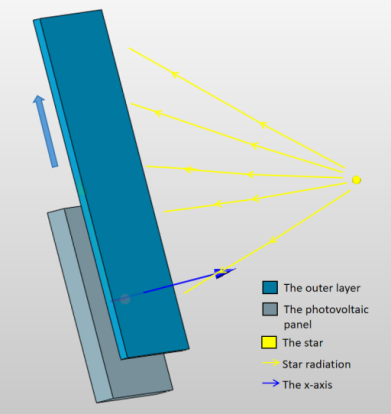
Figure 4. Structure of the outer layer of the space craft and the photovoltaic panel.
Photovoltaic technology is the most often used technology that can convert solar radiation into electrical energy [4]. To absorb the stellar radiation, the outer most layer of the space craft will be covered in photovoltaic panels which can be exposed to the sun. However, while traveling the outer most layer of the space craft can possibly be deteriorated by other forms of disturbance. Solely constructing the outer layer of the space craft by photovoltaic panels can expose the panels to potential hazardous collision and lead to fatal consequences. To protect the photovoltaic panels, the outer layer should be flexible which exposes the huge layer of photovoltaic panels to the star radiation whenever conditions are met for solar energy collection. Figure 4 gives a visual graph of a possible designation of the solar panels and the protective outer layer of space craft which the outer layer moves away while leaving the solar panels facing the star.

Figure 5. A model for photovoltaic panels around the space craft.
The spaceship can take any orientation in space and has a spin itself so that radiation of a star can come from multiple directions when the spacecraft is trying to stay in orbit with a star. The design of space craft must put several photovoltaic panels in each direction to absorb the energy from different direction. Another reason for such a design is for the consideration of a multiple star system. If the journey has encountered a multiple star system, solar radiation can come from multiple directions. Assuming that the space craft is in the shape of an ellipsoid, there should be panels at all angles. Figure 5 provides a possible model for the arrangement of photovoltaic panels. There are sixteen photovoltaic panels in total with 2 main panels covering the top and bottom and others staying around.
3.3. Energy consuming
The gathered energy from the stars can be consumed for several different use. The major expenditure of consumable energy is propulsion. The spacecraft need propulsion system to accelerate the body and switch directions. Other expenditures of energy include daily supply of electricity and other operating systems on the space craft. The consumption of energy is hard to evaluate by exact numbers due to the high uncertain conditions of space traveling. For instance, the actual distances to travel between stars have huge uncertainties. The number of lives and resources on the journey is also a question that must not be overlooked because the mass of the spaceship has an indispensable effect on energy consumption. There are too many indeterminable things while trying to evaluate energy consumption. However, one thing to be sure of is the capacity of stored energy should be big enough for long term journey.
4. Attitude Control System
Changing altitude in space is a hard task especially when the spacecraft is trying to work in space. However, it is vital in space traveling to avoid crashing into a star or with an astronomical object. Losing air as medium implies that there is no outer force that can help the spacecraft to switch directions. The key techniques to the design of the direction system is hidden behind the falling cat problem.
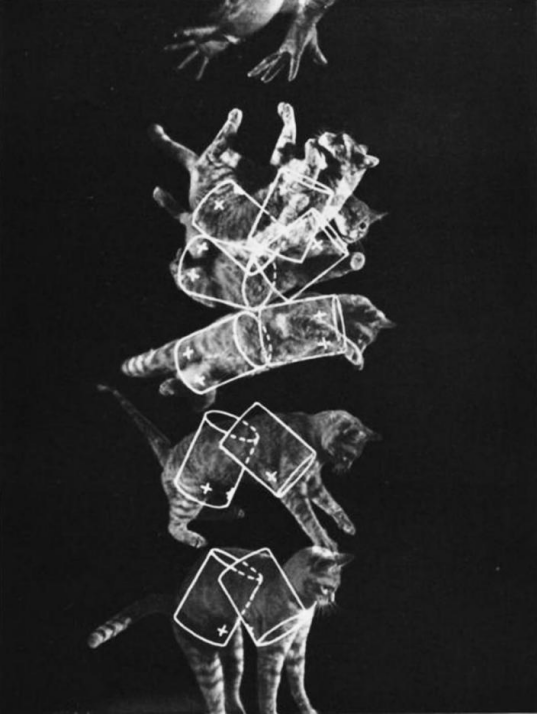
Figure 6. Photo in 1969 that helped explain the falling cat problem [5].
In 1882, French Scientist John Marley invented the first Chronophotographic Gun, and he posted a video of cat falling to the public. This raises scientists’ attractions to cat falling problems. Cats can automatically adjust their positions in the space and land on their claws during the process of falling to the ground no matter which way they faced. The cat falling phenomenon was incomprehensible while considering the law of conservation of angular momentum. It is impossible for a cat to change their directions in the sky without an external torque acting on it. It was not until 1969 that Thomas Kane, an engineer from Stanford, discovered the physical theory behind the phenomenon. He presented the solution to the problem by splitting the cat’s upper and lower body into two cylinders and modeling the fall using computer [6]. Figure 6 is the photo that helped NASA to investigate the problem of astronauts switching direction in space in 1969.
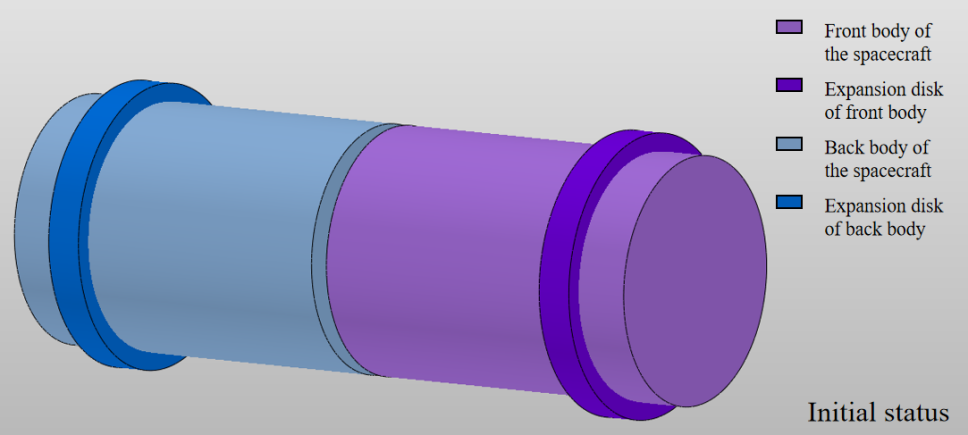
Figure 7. Model that simulates the spacecraft’s initial status before direction changes.
The trick that cats use when they are falling is the way their body react. Firstly, they tighten their upper legs to their bodies and extend their lower legs. While the upper body spins for, for instance, 190 degrees clockwise, the downer body must spin counterclockwise for 10 degrees due to the conservation of angular momentum. In the next step, they tighten their lower legs to their body and spin their downer bodies for 190 degrees in clockwise. Similarly, their upper bodies must spin counterclockwise for 10 degrees to cancel out the torque. In this way they can maintain the conservation of angular momentum without being subjected to external torque [7]. The rule could also be applied to the orientation controlling system of the space craft. When the space craft is intended to adjust its orientation, the front part of the spacecraft decrease its moment of inertia by contracting the radius of spacecraft and move an angle that’s a little greater than the intended angle while the back part of the spacecraft increase its moment of inertia and turn in the opposite direction in a small angle. After the front part gets to its later position, it increases its moment of inertia, and the back part decreases its moment of inertia and to turn the back body to the intended angle. The front part of the body will experience a torque in the opposite direction and finally get to the intended angle. Figure 7 is a monitored model that simulates the spacecraft’s initial status before altitude changes. The entire process of changing altitude in space is monitored. Figure 8 presents the first working process of altitude controlling. Figure 9 shows the second working process of altitude controlling. Figure 10 gives the third working process of altitude controlling. Figure 11 demonstrates the final working process of altitude controlling.
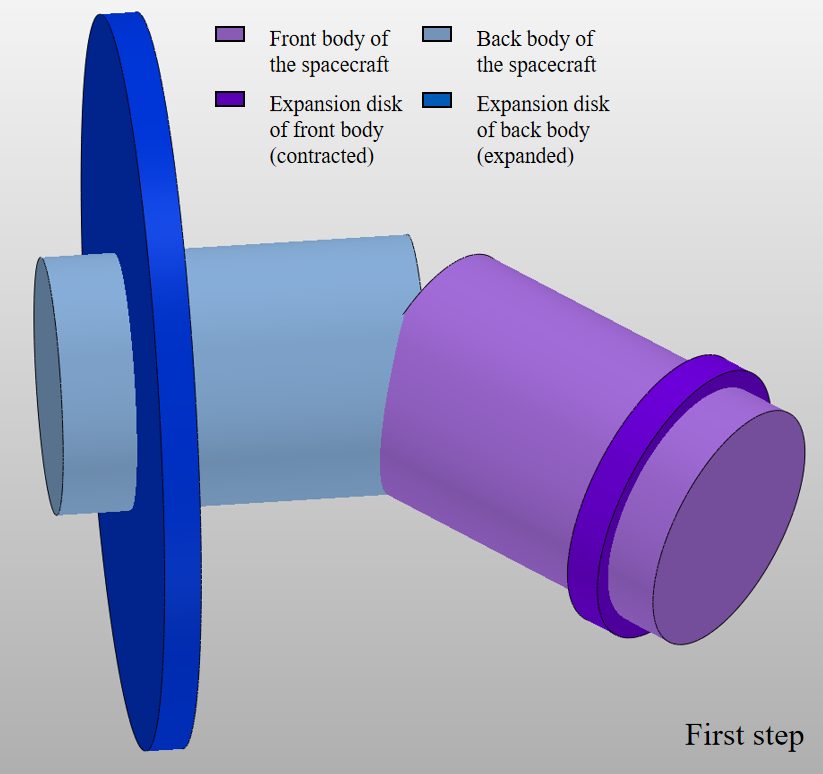
Figure 8. The first working process of altitude controlling.
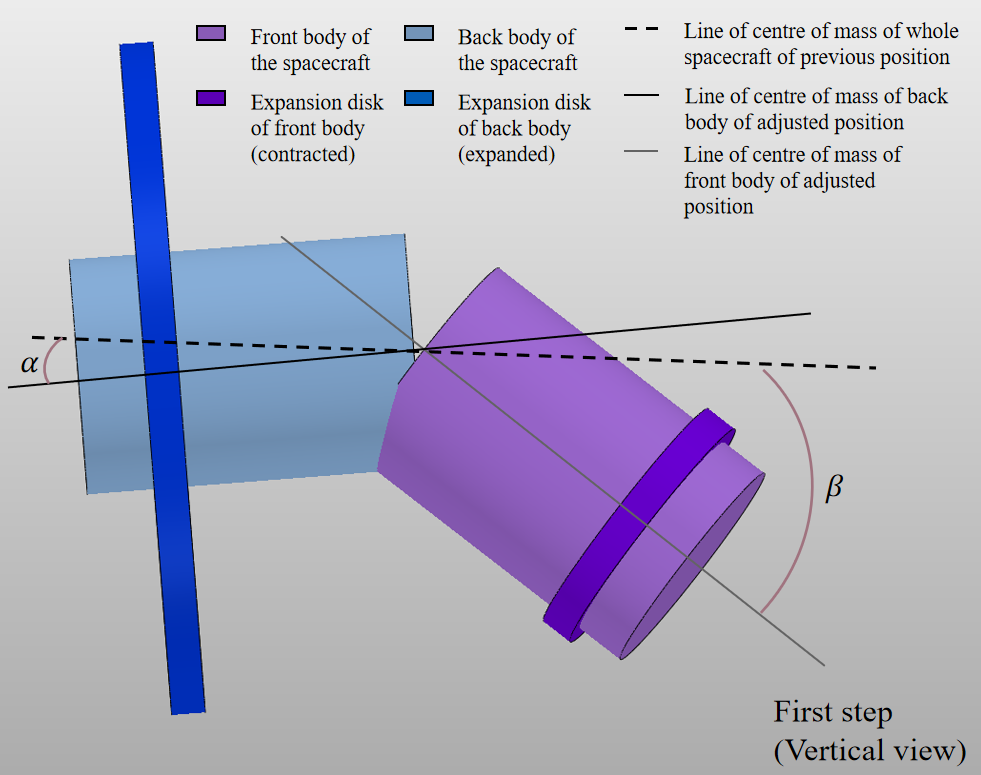
Figure 9. The second working process of changing directions.
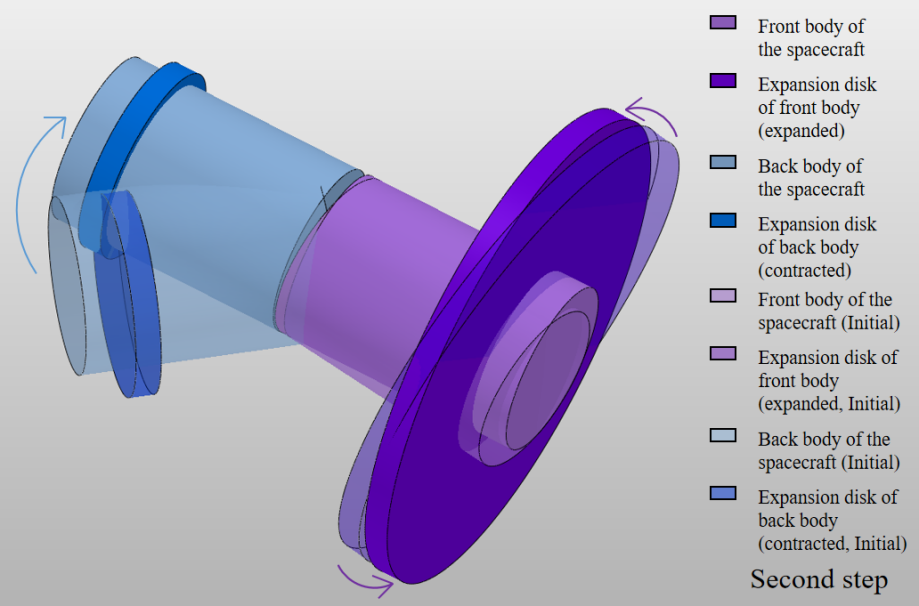
Figure 10. The third working process of changing directions.
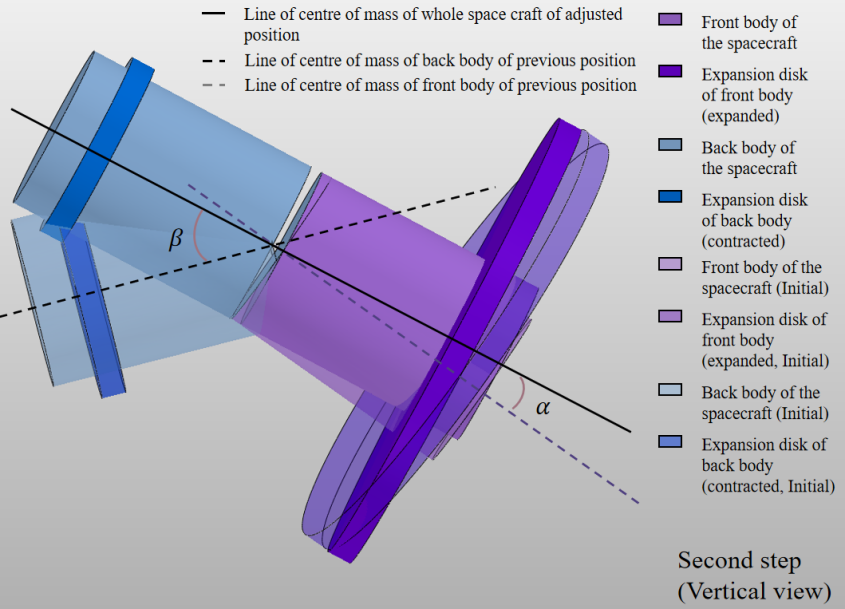
Figures 11. The fourth working process of changing directions.
The final angle that the spacecraft has turned is given by equation (4).
\( θ=β-α \) (4)
5. Navigation System
In space, it is essential to know where the spacecraft is located and where the spacecraft is heading to. The way people determine where they are is by looking at signs and landmarks around. However, it’s not simple to locate where exactly the spacecraft is at in space where it is hard to see things other than asteroids and some close astronomical objects by eye. The key to determine the location is to find “landmarks” as objects of reference. The most effective objects of reference in space are stars. Stars emit strong radiations that can be captured by telescopes. The vast space itself provides eminent conditions for telescopes to work. Telescopes can be set up to face different directions of the sky and determine which direction is the radiation coming from. The precondition of using stars as “landmarks” is that radiation from different stars do differ from each other so that can be recognized. In fact, the precondition is already discovered to be true.
Figure 12. Absorption and emission spectra of different elements [8].
Different stars have different compositions which distinguish the characteristic features in their spectrum. When radiation from the star enters a pile of cold gas, elements in the gas may block a certain number of frequencies and absorb light. A pile of hot gas may also emit radiation with characteristic emission lines as the emission spectrum. Absorption and emission are keys for scientists to determine the compositions of a star. Figure 12 provides the absorption and emission spectrum for several elements.
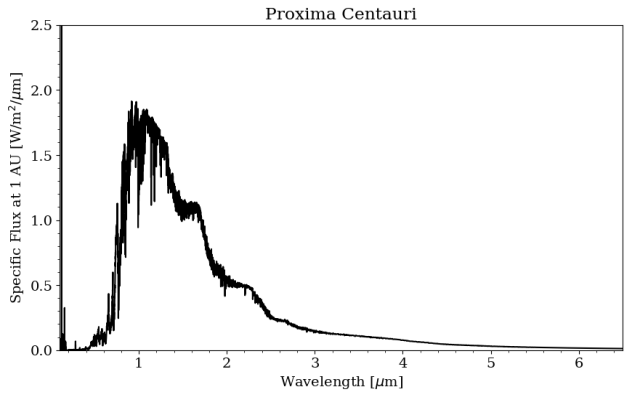
Figure 13. Optical spectra for Proxima Centauri at 1 AU from the star [9].
Figure 13 is the optical spectra for Proxima Centauri at 1 AU from Proxima Centauri. For instance, if the spacecraft is 1 AU from Proxima Centauri, the telescope is probably going to discover a similar spectrum from the direction where Proxima Centauri stays. Similarly, telescopes will capture spectrum from other stars no matter where the spacecraft stays at to navigate the spacecraft.
6. Habitable Zones
It is essential for the spacecraft to maintain at a radiation level where the outer shell of the spacecraft can provide shelter from the radiation. That is why a safety zone must be calculated before reaching the star system. Habitable zone is a reasonable level for the spacecraft to stay at. To make the photoelectric planes on the spacecraft to gain enough star radiation from the star to turn into energy and at the same time to gather information from more Earth-like planets for possible future immigration and more resources.
The habitable zone of a star means that the equilibrium temperatures of the planets surrounding the star in that certain range of distance are possible for water to maintain as liquid on the planets. To account for this and other greenhouse effects, the range of equilibrium temperature of a planet inside the habitable zone should in between 175K to 270K [10]. The stellar luminosity \( {L_{*}} \) is given by the Stefan-Botltzmann law and flux \( {F_{*}} \) reaching the planet from its distance to the star d. \( {R_{*}} \) and \( {T_{*}} \) are radius and surface temperature of the star respectively and \( σ \) is the Boltzman’s constant.
\( {L_{*}}=4πσ{{R_{*}}^{2}}{{T_{*}}^{4}} \) (5)
\( {F_{*}}=\frac{{L_{*}}}{4π{d^{2}}}=σ{(\frac{{R_{*}}}{d})^{2}}{{T_{*}}^{4}} \) (6)
When a planet reaches its equilibrium temperature, the planet has the same amount of absorbed radiation and emitted radiation [11]. Which means that the rate of energy absorption is equal to the rate of energy emission. The following equations give the absorption rate and re-radiation rate. A and \( {R_{p}} \) are the albedo and radius of the planet. \( {T_{eq}} \) is the equilibrium temperature of the planet.
\( \frac{d{E_{absorption}}}{dt}=(1-A)π{{R_{p}}^{2}}{F_{*}}=(1-A)π{{σR_{p}}^{2}}{(\frac{{R_{*}}}{d})^{2}}{{T_{*}}^{4}} \) (7)
\( \frac{d{E_{emission}}}{dt}=4πσ{{R_{p}}^{2}}{{T_{eq}}^{4}} \) (8)
By combing the equation (7) and equation (8), the function of equilibrium temperature can be expressed by equation (9).
\( {T_{eq}}={(1-A)^{1/4}}{(\frac{{R_{*}}}{2d})^{1/2}}{T_{*}} \) (9)
A function for the distance to the star, d, is derived in equation (10).
\( d = \frac{{R_{*}}}{2}{(1-A)^{1/2}}{(\frac{{T_{*}}}{{T_{eq}}})^{2}} \) (10)
Figures 14-16 provide an estimation for both outer and inner boundaries of habitable zones.
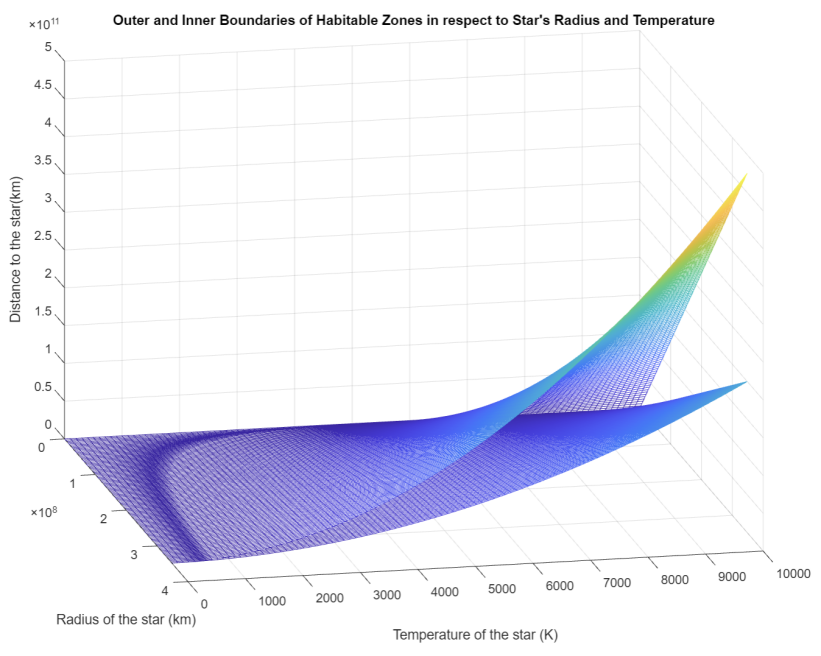
Figure 14. Outer and Inner Boundaries of Habitable Zones in respect to Star’s Radius and Temperature.
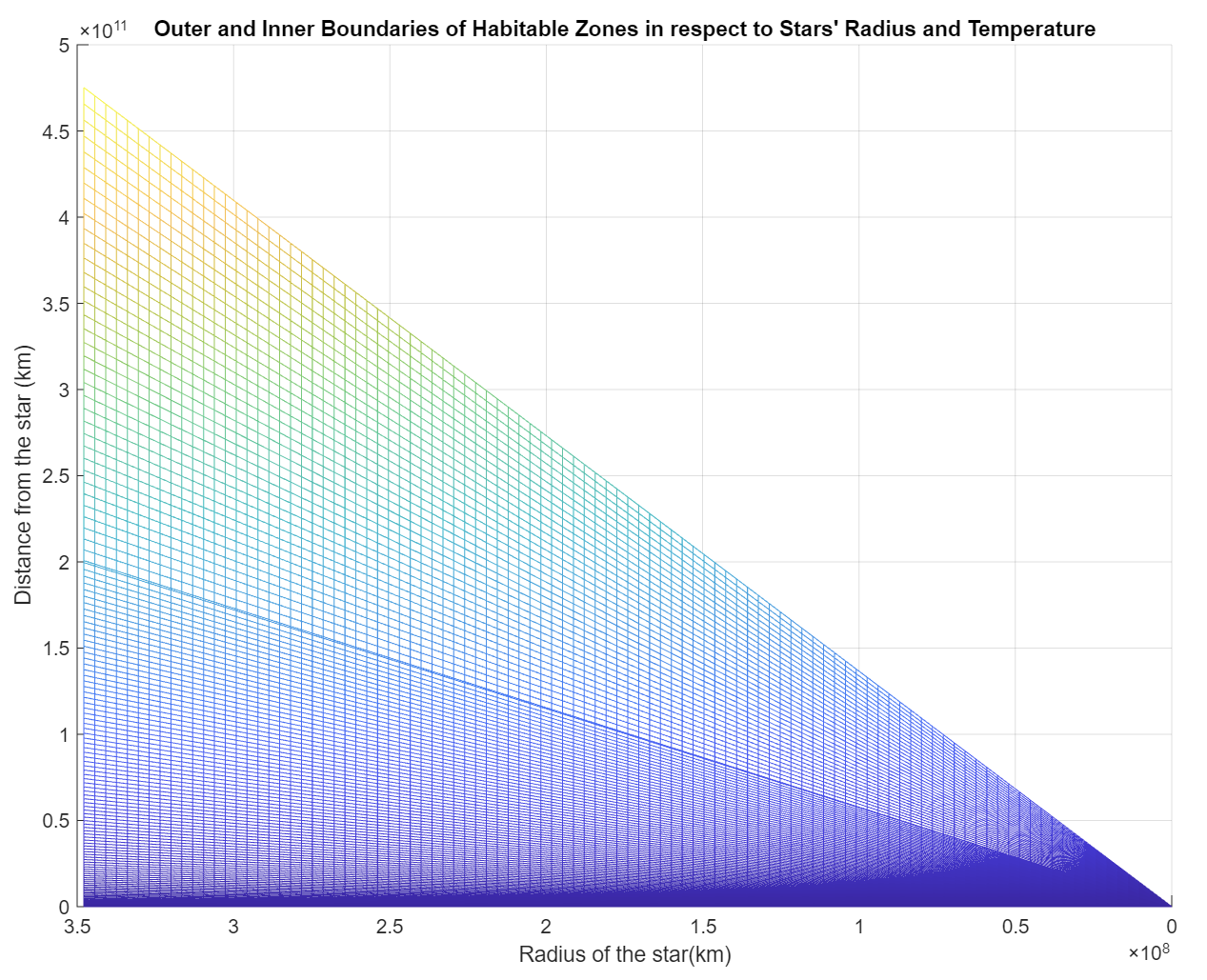
Figure 15. Outer and Inner Boundaries of Habitable Zones in respect to Star’s Radius.

Figure 16. Outer and Inner Boundaries of Habitable Zones in respect to Temperature.
In Figure 14-16, The figure of distance from the star to outer and inner boundaries of habitable zones in respect to radius and temperature of the star. The upper plane shows the distance from the stars to the outer boundaries, and the lower plane shows the distance from the stars to the inner boundaries. The range of habitable zones increase as the radius and temperature of the star increase. However, the inner boundary of habitable zone goes farther way from the star as radius and temperature increase. This implies that for a growing main sequence star the habitable zone of the star will gradually move farther away from the star. Which also implies that Earth will one day be inhabitable for human to live. Immigration and space travel are a determined future task.
7. Conclusion
Space immigration will be an unavoidable topic in the future for long-term development of humankind. According to part four, the boundaries of the habitable zone of a main sequence star will expand as it ages and its temperature and radius will increase. During the process of stellar evolution, the Earth will one day be out of the habitable zone of the sun. This will result in the mass extinction of all live on Earth if humans don’t have the ability to travel to other stellar systems by then. As technology develops, interstellar travel will no longer be purely theoretical. This paper established some potential designs of future interstellar travel programs and explained some of the theories behind them. Future investigations can be based on each subpart of the paper to create a spacecraft suitable for interstellar travel. This paper provided several solutions to the problems central to interstellar travel, as well as methods to monitor the boundaries of the habitable zones of stars. The proposed solutions to power, attitude control and navigation systems include uses of photoelectric panels, solving the falling cat problem and identification of nearby stars. The approaches outlined in this paper to construct a viable spacecraft capable of intergalactic travel are important because travel between galaxies will be unavoidable if human beings wish to survive in this universe long-term.
References
[1]. Christensen, L.L., Hainaut, O., & Pierce-Price, D.P. (2014). What Determines the Aesthetic Appeal of Astronomical Images. CAPjournal. No.14: 20–24.
[2]. Perryman, M. (2021). Stellar Structure and Evolution. Fundamentals of Astrophysics. Choice Reviews. https://doi.org/10.5860/choice.27-6327
[3]. California Institute of Technology. (2019). Solar System Sizes and Distances Reference Guide. https://www.jpl.nasa.gov/edu/pdfs/scaless_reference.pdf
[4]. Fares, M.A., Atik, L., Bachir, G., & Aillerie, M. (2017). Photovoltaic panels characterization and experimental testing. Energy Procedia, 119, 945-952.
[5]. Crane, T. (2021). The ‘falling cat’ phenomenon that helped NASA prepare astronauts for zero gravity, 1969. https://www.libraryhistt.com/2022/10/the-falling-cat-phenomenon-that-helped.html
[6]. Kane, T.R., & Scher, M. (1969). A dynamical explanation of the falling cat phenomenon. International Journal of Solids and Structures, 5, 663-670.
[7]. Essén, H., & Nordmark, A.B. (2018). A simple model for the falling cat problem. European Journal of Physics, 39.
[8]. M.Richmond, Rochester Institute of Technology. spiff.rit.edu/classes/phys301/lectures/spectra/spec_rev _orientation.gif
[9]. Meadows et al. (2018). Proxima Centauri Spectrum. vpl.astro.washington.edu/spectra/stellar/proxcen.htm
[10]. Kaltenegger, L., & Sasselov, D.D. (2011). EXPLORING THE HABITABLE ZONE FOR KEPLER PLANETARY CANDIDATES. The Astrophysical Journal Letters, 736.
[11]. Del Genio, A.D., Kiang, N.Y., Way, M.J., Amundsen, D.S., Sohl, L.E., Fujii, Y., Chandler, M.A., Aleinov, I., Colose, C.M., Guzewich, S.D., & Kelley, M. (2018). Albedos, Equilibrium Temperatures, and Surface Temperatures of Habitable Planets. The Astrophysical Journal, 884.
Cite this article
Ouyang,L. (2024). Spacecraft design for interstellar travel. Theoretical and Natural Science,41,154-166.
Data availability
The datasets used and/or analyzed during the current study will be available from the authors upon reasonable request.
Disclaimer/Publisher's Note
The statements, opinions and data contained in all publications are solely those of the individual author(s) and contributor(s) and not of EWA Publishing and/or the editor(s). EWA Publishing and/or the editor(s) disclaim responsibility for any injury to people or property resulting from any ideas, methods, instructions or products referred to in the content.
About volume
Volume title: Proceedings of the 2nd International Conference on Mathematical Physics and Computational Simulation
© 2024 by the author(s). Licensee EWA Publishing, Oxford, UK. This article is an open access article distributed under the terms and
conditions of the Creative Commons Attribution (CC BY) license. Authors who
publish this series agree to the following terms:
1. Authors retain copyright and grant the series right of first publication with the work simultaneously licensed under a Creative Commons
Attribution License that allows others to share the work with an acknowledgment of the work's authorship and initial publication in this
series.
2. Authors are able to enter into separate, additional contractual arrangements for the non-exclusive distribution of the series's published
version of the work (e.g., post it to an institutional repository or publish it in a book), with an acknowledgment of its initial
publication in this series.
3. Authors are permitted and encouraged to post their work online (e.g., in institutional repositories or on their website) prior to and
during the submission process, as it can lead to productive exchanges, as well as earlier and greater citation of published work (See
Open access policy for details).
References
[1]. Christensen, L.L., Hainaut, O., & Pierce-Price, D.P. (2014). What Determines the Aesthetic Appeal of Astronomical Images. CAPjournal. No.14: 20–24.
[2]. Perryman, M. (2021). Stellar Structure and Evolution. Fundamentals of Astrophysics. Choice Reviews. https://doi.org/10.5860/choice.27-6327
[3]. California Institute of Technology. (2019). Solar System Sizes and Distances Reference Guide. https://www.jpl.nasa.gov/edu/pdfs/scaless_reference.pdf
[4]. Fares, M.A., Atik, L., Bachir, G., & Aillerie, M. (2017). Photovoltaic panels characterization and experimental testing. Energy Procedia, 119, 945-952.
[5]. Crane, T. (2021). The ‘falling cat’ phenomenon that helped NASA prepare astronauts for zero gravity, 1969. https://www.libraryhistt.com/2022/10/the-falling-cat-phenomenon-that-helped.html
[6]. Kane, T.R., & Scher, M. (1969). A dynamical explanation of the falling cat phenomenon. International Journal of Solids and Structures, 5, 663-670.
[7]. Essén, H., & Nordmark, A.B. (2018). A simple model for the falling cat problem. European Journal of Physics, 39.
[8]. M.Richmond, Rochester Institute of Technology. spiff.rit.edu/classes/phys301/lectures/spectra/spec_rev _orientation.gif
[9]. Meadows et al. (2018). Proxima Centauri Spectrum. vpl.astro.washington.edu/spectra/stellar/proxcen.htm
[10]. Kaltenegger, L., & Sasselov, D.D. (2011). EXPLORING THE HABITABLE ZONE FOR KEPLER PLANETARY CANDIDATES. The Astrophysical Journal Letters, 736.
[11]. Del Genio, A.D., Kiang, N.Y., Way, M.J., Amundsen, D.S., Sohl, L.E., Fujii, Y., Chandler, M.A., Aleinov, I., Colose, C.M., Guzewich, S.D., & Kelley, M. (2018). Albedos, Equilibrium Temperatures, and Surface Temperatures of Habitable Planets. The Astrophysical Journal, 884.










